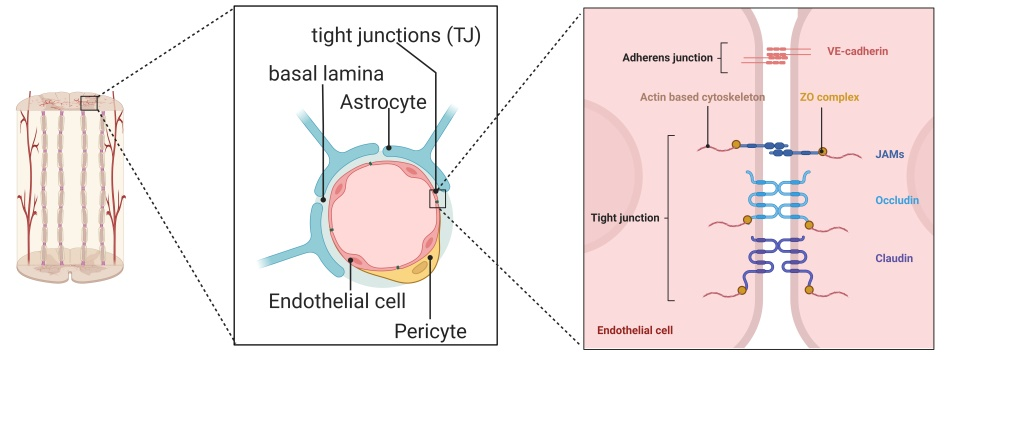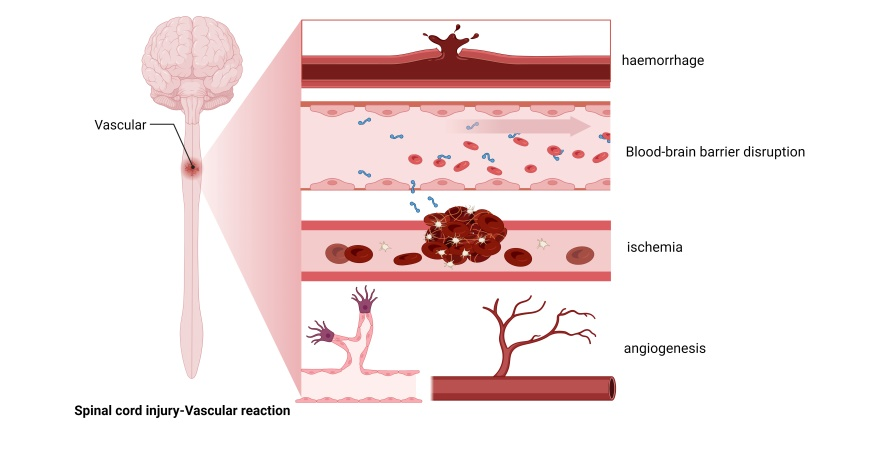NRR:首都医科大学的金柱团队报道创伤性脊髓损伤微循环中的靶向药物治疗
撰文:王荣荣,白金柱
创伤性脊髓损伤(traumatic spinal cord injury,TSCI)导致严重的感觉、运动和自主神经系统功能障碍[1-2]。全球TSCI发生率逐年提高[3-4]。脊髓损伤(spinal cord injury, SCI)后,各种有害因素(包括炎症细胞、炎症因子等)通过脊髓微循环进入神经系统,进而导致不利神经修复的微环境。目前仍缺乏对于脊髓创伤的有效治疗方案。脊髓微循环作为脊髓重要组织,可以限制各种有害因素进入神经系统,确保在神经系统中形成稳定的内部环境,发挥神经保护作用(图1)。脊髓损伤后,脊髓血管反应主要包括血管破裂和出血、血脊髓屏障中断、血液供应/缺血、内源性血管生成(图2)[5]。在原发性损伤阶段和继发性损伤阶段发挥重要作用[6-7]。总之,脊髓微循环在SCI整个病理过程都发挥保护作用。因此保护内皮细胞的功能和完整性,防止血脊髓屏障(Blood spinal cord barrier ,BSCB)破坏是减少严重继发性损伤的重要措施,可能成为SCI的潜在治疗策略。然而,创伤性脊髓损伤微循环靶向的药物治疗仍缺乏深入而全面的总结。

图1血脊髓屏障主要成分示意图

图2脊髓损伤-血管反应
近日,首都医科大学康复医学院的白金柱团队在《中国神经再生研究(英文版)》(Neural Regeneration Research)上发表了题为“Pharmacological interventions targeting the microcirculation following traumatic spinal cord injury”的文章,认为脊髓微循环为靶点的药物对SCI后的功能恢复具有良好的效果。神经营养因子相关药物、化学合成药物和生物制剂、糖皮质激素、内源性血管活性物质抑制剂或拮抗剂、基质金属蛋白酶相关药物、人免疫球蛋白G、一氧化碳供体等药物可减轻血脊髓屏障损伤,增强内膜保护,诱导血管内皮修复和再生,改善脊髓血流量,改善损伤微环境,促进脊髓组织修复。综上所述,以脊髓微循环为靶点的药物可能是治疗SCI一种有效方法。然而,需要注意一些局限性。首先,文献收集仅限于PubMed数据库。未来可增加Embase数据库和Cochrane数据库,实现更全面的数据收集。二是本文局限于靶向脊髓微循环的药物对结构和功能的影响,未来可在分子水平或通路水平进一步研究。
虽然许多类型的药物(化学合成物、神经营养因子和皮质醇等)已被研究作为治疗脊髓微循环损伤的潜在方法,但其临床应用在很大程度上受到多方面的限制,例如药物的输送、剂量的把控、时间窗的选择等。近年来,干细胞工程和材料科学的发展,增加了SCI治疗的希望。尽管进行了大量研究,但仍然难以找到一种能够完全应对SCI挑战的理想治疗方法,这些挑战很可能不容易通过单一药物或材料解决,而是需要一种组合方法。因此,需要更多针对SCI多方面的机制进行组合治疗的研究。

通讯作者:白金柱,中国康复研究中心北京博爱医院脊柱脊髓外科,主任医师,副教授,硕士生导师,博士,博士后,留欧学者。德国脊柱微创访问学者,欧洲脊柱学会培训中心Saint-Pierre医院脊柱专科培训医师,比利时鲁汶大学Saint-Luc医院和根特大学总医院访问学者。入选北京市科技新星计划。获中国康复医学会科学技术奖二等奖,首都医科大学优秀研究生导师奖、康复医学院优秀教师奖,北京大学优秀博士学位论文二等奖。主持国家自然科学基金等课题10余项,国内外发表论文50余篇,副主译和参编专著5部,获专业学会和期刊优秀论文奖4篇。获批国家专利4项。脊柱脊髓外科与康复相结合为临床专业特色,脊髓损伤基础与临床研究为重点科研方向。
第一作者:王荣荣,首都医科大学康复医学院,中国康复研究中心北京博爱医院脊柱脊髓外科,硕士研究生。
中国康复研究中心重点项资助
创伤性脊髓损伤被认为是一种毁灭性的疾病,主要表现为感觉、运动、自主神经功能障碍,严重影响日常生活能力。这些不良结果与脊髓损伤机制复杂、中枢神经元的再生能力有限以及创伤性损伤形成的抑制环境密切相关。微循环障碍是脊髓继发性损伤的重要病理生理机制。多种治疗药物已被证明可以改善创伤环境、减轻继发损伤或促进再生/修复。其中,脊髓微循环已成为治疗脊髓损伤的重要靶点,以微循环为靶点的药物干预可改善脊髓损伤的微环境、促进脊髓损伤的恢复。这些药物靶向脊髓微循环的结构和功能,对维持脊髓神经元、轴突和胶质细胞的正常功能至关重要。本综述就脊髓微循环在SCI中的病理生理作用,包括脊髓微循环的结构和SCI引起的脊髓微循环的组织病理学改变进行讨论。 并对SCI后针对脊髓微循环的药物治疗进展进行总结。
原文链接:https://doi.org/10.4103/1673-5374.375304
参考文献
[1]David G, Mohammadi S, Martin AR, et al. Traumatic and nontraumatic spinal cord injury: pathological insights from neuroimaging. Nat Rev Neurol. 2019;15:718-731.
[2]Ahuja CS, Nori S, Tetreault L, et al. Traumatic spinal cord injury—Repair and regeneration. Neurosurgery 2017;80:S9-22.
[3]Li B, Qi J, Cheng P, Yin P, et al. Traumatic spinal cord injury mortality from 2006 to 2016 in China. J Spinal Cord Med. 2021;44:1005-1010
[4]Chiu WT, Lin HC, Lam C, et al. Review paper: epidemiology of traumatic spinal cord injury: comparisons between developed and developing countries. Asia Pac J Public Health. 2010;22:9-18.
[5]Yao C, Cao X, Yu B. Revascularization after traumatic spinal cord injury. Front Physiol. 2021;12:631500
[6]Alizadeh A, Dyck SM, Karimi-Abdolrezaee S. Traumatic spinal cord injury: an overview of pathophysiology, models and acute injury mechanisms. Front Neurol. 2019;10:282.
[7]Wang D, Wang K, Liu Z, et al. Valproic acid-labeled chitosan nanoparticles promote recovery of neuronal injury after spinal cord injury. Aging (Albany NY). 2020;12:8953-8967


